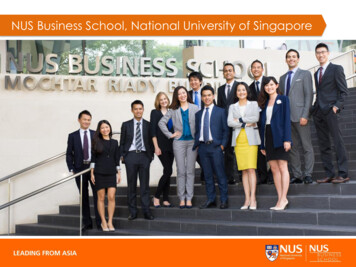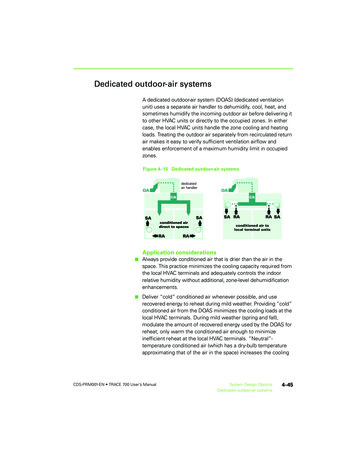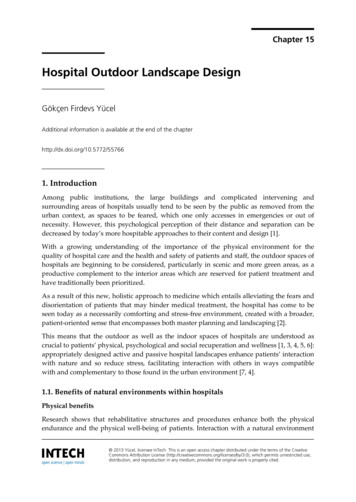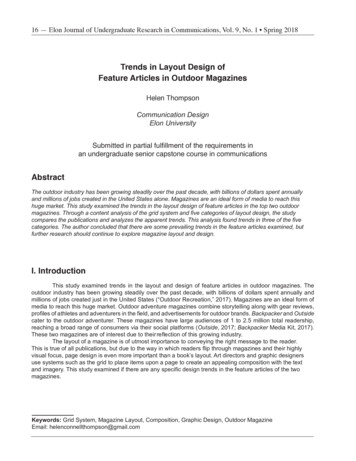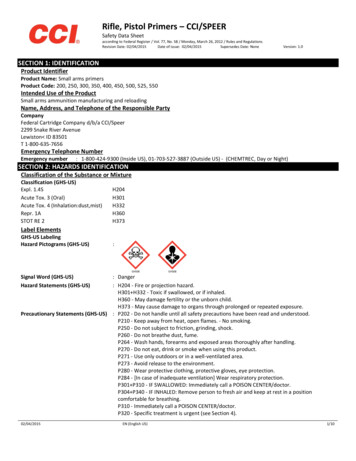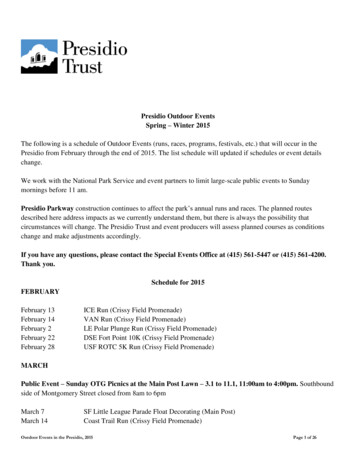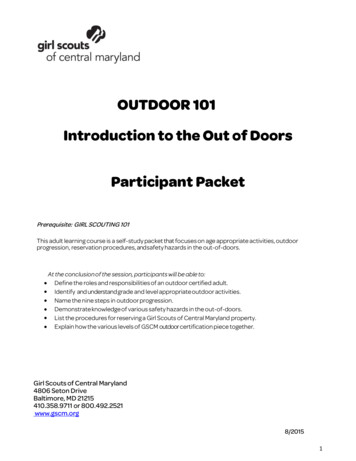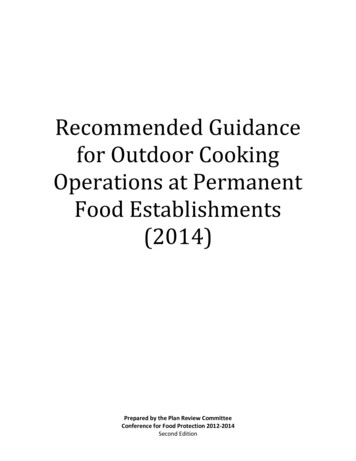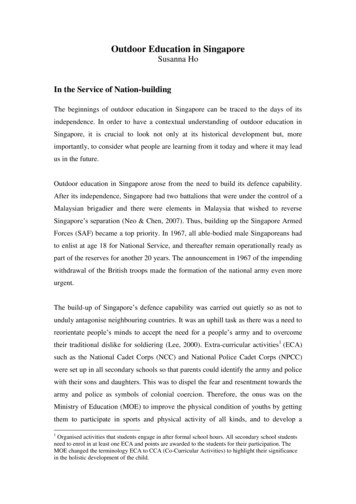
Transcription
Outdoor Education in SingaporeSusanna HoIn the Service of Nation-buildingThe beginnings of outdoor education in Singapore can be traced to the days of itsindependence. In order to have a contextual understanding of outdoor education inSingapore, it is crucial to look not only at its historical development but, moreimportantly, to consider what people are learning from it today and where it may leadus in the future.Outdoor education in Singapore arose from the need to build its defence capability.After its independence, Singapore had two battalions that were under the control of aMalaysian brigadier and there were elements in Malaysia that wished to reverseSingapore’s separation (Neo & Chen, 2007). Thus, building up the Singapore ArmedForces (SAF) became a top priority. In 1967, all able-bodied male Singaporeans hadto enlist at age 18 for National Service, and thereafter remain operationally ready aspart of the reserves for another 20 years. The announcement in 1967 of the impendingwithdrawal of the British troops made the formation of the national army even moreurgent.The build-up of Singapore’s defence capability was carried out quietly so as not tounduly antagonise neighbouring countries. It was an uphill task as there was a need toreorientate people’s minds to accept the need for a people’s army and to overcometheir traditional dislike for soldiering (Lee, 2000). Extra-curricular activities1 (ECA)such as the National Cadet Corps (NCC) and National Police Cadet Corps (NPCC)were set up in all secondary schools so that parents could identify the army and policewith their sons and daughters. This was to dispel the fear and resentment towards thearmy and police as symbols of colonial coercion. Therefore, the onus was on theMinistry of Education (MOE) to improve the physical condition of youths by gettingthem to participate in sports and physical activity of all kinds, and to develop a1Organised activities that students engage in after formal school hours. All secondary school studentsneed to enrol in at least one ECA and points are awarded to the students for their participation. TheMOE changed the terminology ECA to CCA (Co-Curricular Activities) to highlight their significancein the holistic development of the child.
positive attitude toward adventure and strenuous activities. Schools started organisingadventure courses for their students in response to Singapore’s leaders’ call for thebuilding of a “rugged and dynamic” (Lee, 2000, p. 25) society. In those days, most ofthese courses were organised by the British Army and were mainly based in PulauUbin, a less developed island close to the main island of Singapore. Therefore, theearly days of outdoor education was in the form of adventure courses to buildruggedness in the young to prepare for Singapore’s military defence.Outward-boundIn 1967, Dr Goh Keng Swee, the Minister for Defence and Interior, mooted the ideaof an Outward Bound School (OBS) in Singapore. Two New Zealanders, HamishThomas and Al Cameron, were invited to help set up OBS that year. The OBS wasintended to help build the “rugged” society (Outward Bound Singapore, 2007). Thefirst OBS course in February 1968 was improvised with few resources. When Thomasand Cameron returned to New Zealand, local instructors began to develop morelocalised OBS courses in 1969. For instance, the instructors built an obstacle course inthe waters surrounding Singapore in addition to the conventional land-based obstaclescourses. They learnt from kelong operators how kelongs were built, and then usedthose techniques to build an obstacle course that extended from the beach into the sea(Outward Bound Singapore, 2007). The management of OBS moved from thePeople’s Association (PA) to the Ministry of Defence (MINDEF) in 1971. Thischange had a number of significant implications, such as army officers replacing thepool of OBS instructors. Under the training division of the army, the OBS became aconduit for the provision of adventure and leadership training to young men andwomen, and also provided a way to give ordinary Singaporeans a taste of military life.From 1982, all male students in the NCC were to be exposed to the rigours andchallenge of tougher training (Koh, 1982). Thus, other than the courses at OBS, theirtraining included foot-and-arms drills, rifle range practice, map-reading ororienteering, topography marches, campcraft, section training and annual weekendcamps. According to Nancy Koh (1982), the aim was to develop rugged and confidentboys who would find it easier to adapt to national service when enlisted. However,such uniformed groups and OBS activities were gradually extended to girls. Launchedin 1989, the National Camp that was held to coincide with the National Day
celebrations, brought together students from eight uniformed groups (Chua, 1989).Outdoor activities such as canoeing, orienteering, telematches and campfire wereconducted during the National camps to toughen the students both physically andmentally. Even today, these camps remain as platforms for members of variousuniformed groups to meet and discuss national issues.In need of a rugged societyTaking a leaf from the British Empire, the ruling elites in the once colonisedSingapore persisted with the early 20th century notion that outdoor activities should beused to develop fitness for war and ruggedness in our young. On more than oneoccasion, the first Prime Minister, Lee Kuan Yew, called on Singaporeans to work tobe a “rugged society” (The Straits Times, 1990, p. 1). He said that if the trend ofrising obesity were left unchecked, it would have adverse effects for the nation as awhole and the SAF in particular. The need for a rugged society came into sharp focusonce again in 1990 when then First Deputy Prime Minister Mr Goh Chok Tongobserved that more Singaporeans were becoming “flabby” (Chua & Tan, 1990).The emphasis on building a rugged society led to the Physical Education (PE)curriculum coming under close scrutiny. In 1990, the PE college appointed aspecialist from Britain, Malcolm Gilbey, to head the outdoor education department.According to Sharon Lim (1990), the department had four lecturers teaching sailing,orienteering, canoeing, campcraft and personal development. The idea was for PEteachers who had been through the course to introduce these outdoor pursuits asECAs in schools. It was uncertain if such adventure activities that had been developedfor an individualistic culture like that of United Kingdom (UK) and United States ofAmerica (USA) would be appropriate for a Singaporean society that places emphasison community and interdependence. Nevertheless, these activities seemed to havebeen widely and uncritically accepted.With rising interest in adventure activities among young Singaporeans, the number ofadventure clubs within community centres rose from 11 in 1985 to 20 in 1990 (Tan,1990). In support of the nation’s call for a rugged society, the MOE endorsed a policyto ensure that every secondary school student goes through at least one residential
camping experience in his or her school life. As a result, camping became the mostpopular outdoor education activity offered by schools. A survey conducted by theMOE in 1991 showed that 98 per cent of primary schools conducted camps for theirstudents (Extra-Curricular Activities Centre, 1991). Therefore, since the 1990s,camping has been established as an important aspect of the education system inSingapore.In 1991, the management of the OBS was returned to PA (Outward Bound Singapore,2007). The aim was to offer Singapore’s young people exciting activities to developtheir physical and mental ruggedness. To support the nation’s efforts, MOEformalised OBS programmes for secondary schools by setting aside a yearly budgetto subsidise their students (Ong, 1990). However, not all students would have achance to go through the OBS due to its limited capacity. Therefore, MOE resourcedtwo adventure centres at Jalan Bahtera and Ponggol with outdoor adventure facilitiesto cater to schools’ outdoor camping programmes. A climbing tower and other teambuilding activity stations were added to the camping and canoeing facilities. About40,000 students up to the junior college level each year were able to get a taste ofoutdoor living and adventure at these centres (Phua, 1996).Almost all schools in Singapore offer their students some form of adventure-basedprogrammes, ranging from camping to overseas expeditions. To maximise the usageof the MOE adventure centres, each school was allocated a three-day two-night slotfor their camps. Indirectly, this led to the growing trend of schools organising campsthat span over a three-day period, accommodating about 300 students each time. Thedesign and nature of schools’ programmes vary from school to school, largelydependent on the availability of each school’s financial, human and physicalresources. The camps are typically adventure-based and include activities such ascampcraft, campfire-making, orienteering, team-building, challenge ropes courses,abseiling and rock-climbing. Many private vendors have also entered the market inservicing schools’ requirements in organising camps for students.Surge of outdoor activitiesIn 1999, outdoor education was included as one of the learning activities at the
college level in the revised physical education syllabus produced by the MOE (Wang,et al., 2006). In the same year, an outdoor education department was formally set upin ECAC under the MOE. The large amount of resources committed to schools’outdoor education programmes and a department to oversee its implementationunderscores the important role it plays in the Singapore education system. Along withthe surge in camping programmes organised by schools, another emerging trend wasfor schools to take students on overseas trips to learn more about other cultures.According to Sandra Davie (2001), 264 schools conducted 786 study trips overseas in2001. Most of these trips were conducted during school holidays and combinedlessons with outdoor pursuits and community service. Schools were sending studentsabroad to pick up skills they could not learn in the classroom in a bid to “toughen up”the country’s youths (Almenoar, 2005a). According to tour operators, adventure tripsoverseas have become popular with secondary school and junior college students. Inthe past few years, hundreds of youngsters have headed for the jungles of Thailand,the mountains of New Zealand and the deep waters off Malaysia, and the numbersappear to be rising (Almenoar, 2005b). The trend is not surprising. According toMaria Almenoar (2005b), the ministry has set aside 4.5 million a year to helpfinance such programmes for students to become more rugged.Since 2004, the MOE launched two new and purpose-built adventure centres to caterto the adventurous teens. The management of the MOE adventure centres has beenoutsourced to private operators and they run programmes for schools throughout theyear, catering to about 70, 000 students annually (Lui, 2006). This move hasunwittingly resulted in more schools taking up the standard three-day two-nightcamping packages for their students. The outsourcing of outdoor educationprogrammes may have worked against MOE’s intent of creating a more diversifiedlandscape in education. The camping packages offered by these vendors are usuallytargeted at mass participation and they offer schools quick-fix solutions to meeting theMOE’s policy of conducting at least two camps for each secondary school student.In fact, the adventure centres were part of an effort to address the view thatSingaporean youths were becoming too soft (Ng & Chan, 2004; Soh, 2004), asituation which former Education Minister Tharman Shanmugaratnam described as abigger challenge for the country than the economic one (Goh, 2004).
Shanmugaratnum stressed the importance of providing our children with a holisticand broad-based education, with a strong emphasis on activities that develop tenacityand strength of character. He felt that sports and rugged activities, such as outdoorcamps or expeditions and uniformed groups, lend themselves to building thesequalities (Shanmugaratnam, 2004). This deviates from the earlier emphasis onbuilding defence capability through outdoor education. The emphasis appears to haveshifted towards inclusiveness so that each child can develop the tenacity to thrive inthe globalised environment. Nancy Carlsson-Paige and Linda Lantieri (2005) pointout that the climate of contemporary education where teachers focus mainly on theacademic matters, leave little time for children to pursue such meaningful connectionsthat could lead to responsible global citizenship.The PE syllabus (Ministry of Education, 2006) that was implemented from 2006effectively marginalises outdoor education as “other physical activities” (p. 40). Thedocument states that outdoor activities could be included in the PE programme as ameans to attain the expected learning outcomes, for example, rock-climbing can beused to develop muscular strength. Other than listing such activities as these, there isno mention of the objectives, scope, content and intended learning outcomes ofoutdoor activities in the PE syllabus document. A recent Singaporean primary schoolreview by MOE (2009), however, acknowledges that the fundamental task ofeducation is beyond academic achievement. The MOE review committee is of theview that learning is holistic, and understanding emerges from active experiences thatmake sense to learners. In the same review, outdoor education has been selected asone of the means of teaching the concepts, values and skills of global education,because it can provide students with authentic experiences that engage them activelyand holistically.Perceptions of learning outcomesPeter Martin (from La Trobe University, Australia then) conducted a survey on 300Singaporean teachers’ perception on the learning outcomes of outdoor education in2006.
Outward-bound In 1967, Dr Goh Keng Swee, the Minister for Defence and Interior, mooted the idea of an Outward Bound School (OBS) in Singapore. Two New Zealanders, Hamish Thomas and Al Cameron, were invited to help set up OBS that year. The OBS was intended to help build the “rugged” society (Outward Bound Singapore, 2007). The first OBS course in February 1968 was improvised with few .


